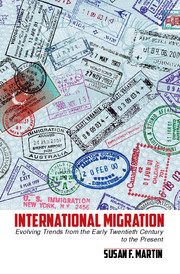Book contents
- Frontmatter
- Contents
- Foreword
- Acknowledgments
- List of Acronyms
- Introduction
- 1 Early Roots
- 2 “The Problem of Refugees”
- 3 Labor Mobility
- 4 Orderly and Humane Migration Management
- 5 Trafficking in Persons
- 6 Migration and International Security
- 7 Migration, the Environment, and Climate Change*
- 8 Migration and Development
- 9 Towards the Future
- Bibliography
- Index
7 - Migration, the Environment, and Climate Change*
Published online by Cambridge University Press: 05 August 2014
- Frontmatter
- Contents
- Foreword
- Acknowledgments
- List of Acronyms
- Introduction
- 1 Early Roots
- 2 “The Problem of Refugees”
- 3 Labor Mobility
- 4 Orderly and Humane Migration Management
- 5 Trafficking in Persons
- 6 Migration and International Security
- 7 Migration, the Environment, and Climate Change*
- 8 Migration and Development
- 9 Towards the Future
- Bibliography
- Index
Summary
In 1990, the Intergovernmental Panel on Climate Change (IPCC) warned that significant levels of migration could occur as a result of changing climatic conditions. This was not the first time, however, that the nexus between migration and the environment was a topic of international attention. The concept of environmental migration proved to be controversial, largely because of the difficulty in measuring the extent to which environmental factors compel people to move. Since the 1980s, when the term “environmental refugees” was coined (El-Hinnawi 1985), experts within the environmental and migration fields have differed in their characterization of the phenomenon.
Dun and Gemmene (2008) places those concerned with the interconnections in two groups – alarmists and skeptics. The alarmists see the environment as a principal cause of population movements, emphasize the forced nature of the migration (hence, the term “refugee”), and often project that hundreds of millions of persons will be affected, frequently without differentiating between those who will move short distances to safer ground versus those who will move thousands of miles to new countries. The skeptics, by contrast, raise questions about the models used to generate estimates of those who will be forced to migrate and emphasize that pull factors in destination locations are often more important than push factors at home in determining whether, where, and in what volume people will migrate. Perhaps it is not surprising that some environmentalists have been particularly alarmist, often using the threat of mass migration as a reason that immediate action should be taken to address climate change and other environmental problems. Migration experts, concerned about a potential backlash against migrants, and misuse of terms like refugee (carefully defined in international law) have tended to join the camp of the skeptics.
- Type
- Chapter
- Information
- International MigrationEvolving Trends from the Early Twentieth Century to the Present, pp. 214 - 234Publisher: Cambridge University PressPrint publication year: 2014
- 1
- Cited by

